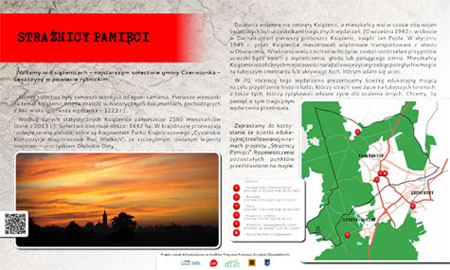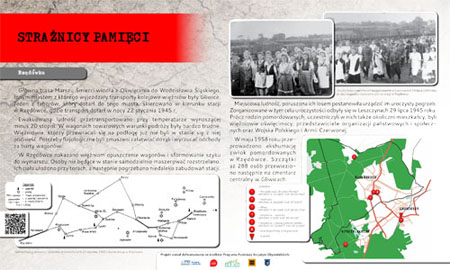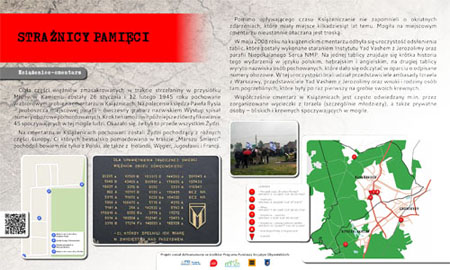Educational path

Table 1
GPS: 50.15420564, 18.59882116
Welcome to Książenice – the oldest village of the administrative area Czerwionka - Leszczyny , in the district of Rybnik. The village has been inhabited since the Stone Age. The
first remarks about Książenice can be found in historical documents dating from 13th century (exactly from 1223).
According to the statistics, the village Książenice is now inhabited by 2580 people (data from 2013). The village covers the area of 1642 hectares. The natural scenery is dominated by vast
green areas which are part of the Landscape Park “ Cistercian Landscape Park of Rudy Wielkie” including shrouded in legend beauty spot “Deep Cavity” (Głębokie Doły).
Książenice and its inhabitants experienced hostilities and tragic events connected with them during both world wars. On 20th September 1942 the first priest of Książenice - Jan Pojda died
in the concentration camp in Dachau. In January 1945, prisoners transported from the concentration camp in Oświęcim marched through Książenice. Many of the prisoners lost
their lives, they were shot while trying to escape or died of exhaustion, died as a result of severe frost or starved to death. The residents of Książenice and neighbouring villages risked their lives when they buried the
dead in the mass grave at the graveyard in Książenice or hid the prisoners who managed to escape.
To commemorate 70th anniversary of those events we would like to present educational path which aims to bring the story of people who lost their lives and the ones who put their own
lives at risk to save other people. We would like to keep these tragic events in mind. We invite you to take advantage of the educational path prepared within the Memory Guards Project. The location of the remaining points is shown on the map.

Table 2
GPS: 50.13972849, 18.61935360
The main route of the Death March led from Oświęcim to Wodzisław Śląski. Gliwice was another city from which rail transport of inmates left. One of the trains which arrived there was directed towards the railway station in Rzędówka, which it reached at night, on 22nd January 1945.
People were transported in open cattle cars at the temperature of minus 20 centigrades. The conditions of that journey were extremely difficult. Prisoners fainted, fell to the floor unable to stand up again. There were no toilets. Prisoners were asked to leave the train at the railway station in Rzędówka and to form arrays
for march. People unable to walk on their own were executed. Their dead bodies were placed beside rails and then buried not far from the buildings of the railway station. Local people moved by the fate of the prisoners decided to arrange respectable funeral, which took place in
Leszczyny on 29th July 1945. The families of the victims, local residents, former inmates of Oświęcim, representatives of state and social organizations, Polish and Red Army soldiers all participated in the funeral.In May 1958, an exhumation was carried out. The remains of as many as 288 people were transported to central graveyard in Gliwice.
Table 3
GPS: 50.12920135, 18.57782567
After leaving the railway station in Rzędówka inmates tried to hide in nearby buildings, they asked local residents for food and water. They wore only shirts and trousers although it was
freezing cold. They were too weak to carry blankets on their backs. While passing the hamlet “Młyny” in Kamień , in the area of Spendlowiec farm, SS soldiers ,
who were escorting the prisoners, planted a grenade under a collapsed tree. At the moment of explosion one of them shouted “Partizen” in German. Then firing started and as a result many prisoners died.
Commemorative plague with information about the dead was placed there, on one of the trees.

Table 4
GPS: 50.15165000, 18.59701000
The bodies of prisoners shot during the firing in the hamlet “Młyny” were buried in the mass grave at the graveyard in Książenice on 26th January and 12th February 1945. The priest Paweł Ryś asked the undertaker (whose surname was Wystup) to write down the concentration camp
numbers of the dead. That step enabled later identification of 45 people lying in the grave. It turned out most of them were Jews.
The Jews buried at the Książenice graveyard came from different parts of Europe. People brutally murdered during the Death March came not only from Poland, but also from the
Netherlands, Hungary, Yugoslavia and France.
Despite the passing time, Książenice residents have not forgotten about the tragic events, which took place tens of years ago. The mass grave is continuously cared for. In May 2008 a
ceremony of unveiling commemorative plagues took place at the graveyard in Książenice. The plagues were prepared thanks to the efforts of Yad Vashem institute from Jerusalem and the parish in Książenice. One plague provides information about those tragic events in Polish,
Hebrew and English and the other contains names of people buried there, who were recognised by the concentration camp numbers. The ceremony gathered the representatives of Israel embassy from Warsaw, the representatives of Yad Vashem from Jerusalem as well as grandchildren and families of the dead, for whom it was the first opportunity to visit the relatives’ grave.
Nowadays the graveyard in Książenice is frequently visited by organised trips from Israel (particularly young people) and individuals – relatives of people buried there.
Table 5
GPS: 50.17112854, 18.58486674
Some of prisoners tried to escape from the Death March. Most of them hid in Książenice and Kamień.
Książenice residents Bronisława and Brunon Jurytko hid and fed 14 prisoners, who succeeded in running away, for 8 days at the same time risking their own and their family’s life and all
their possessions. The prisoners were hidden in the Jurytkos’ barn and they received food and clothes. That fact was confirmed by the document the prisoners prepared: “We, the undersigned – the refugees from Auschwitz concentration camp, announce that
Brunon Jurytko from Książenice offered us shelter for eight days, gave us food, accommodation and all necessary help. It all happened while SS troops were looking for
refugees in that area. He saved our lives that way without obtaining any financial benefit, just because he was a decent man.
Jurytko family was awarded with the medal “ Righteous Among the Nations” by Israeli institute Yad Vashem in 1991
"There is only one thing worse than Auschwitz...
when people forget that such a place existed"

